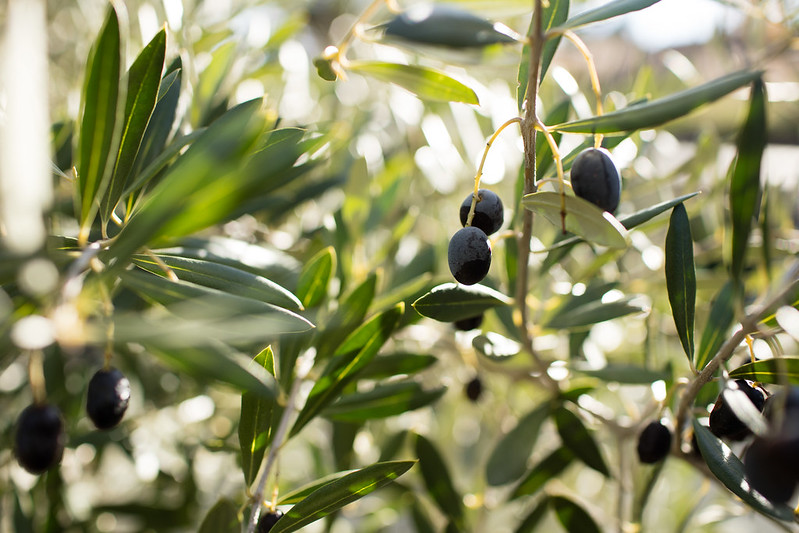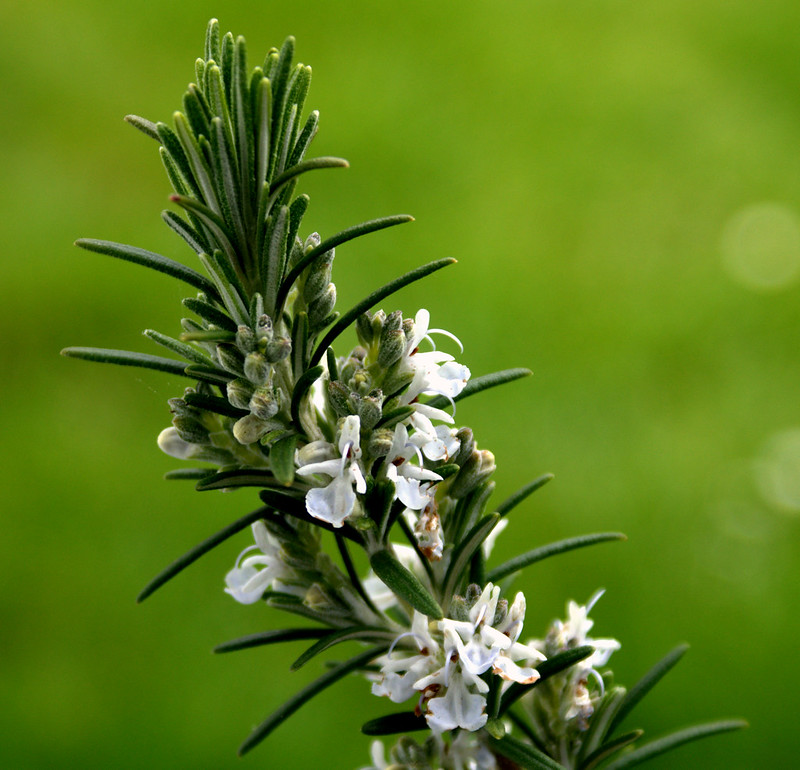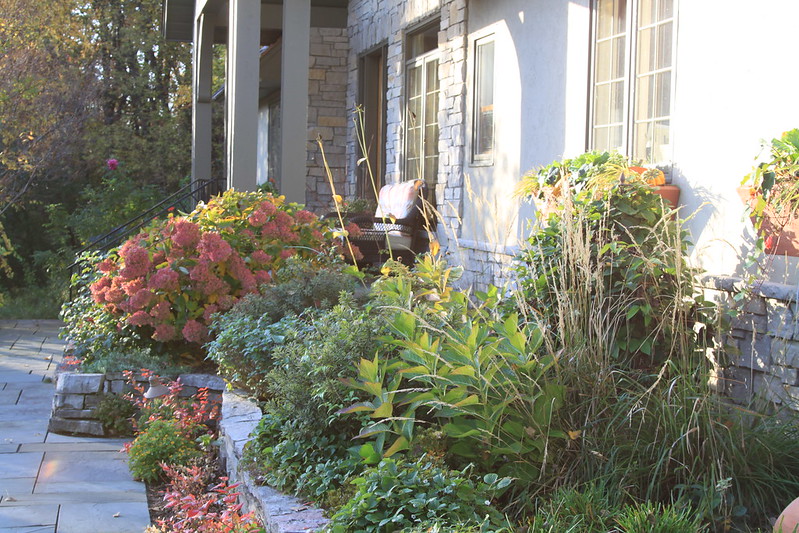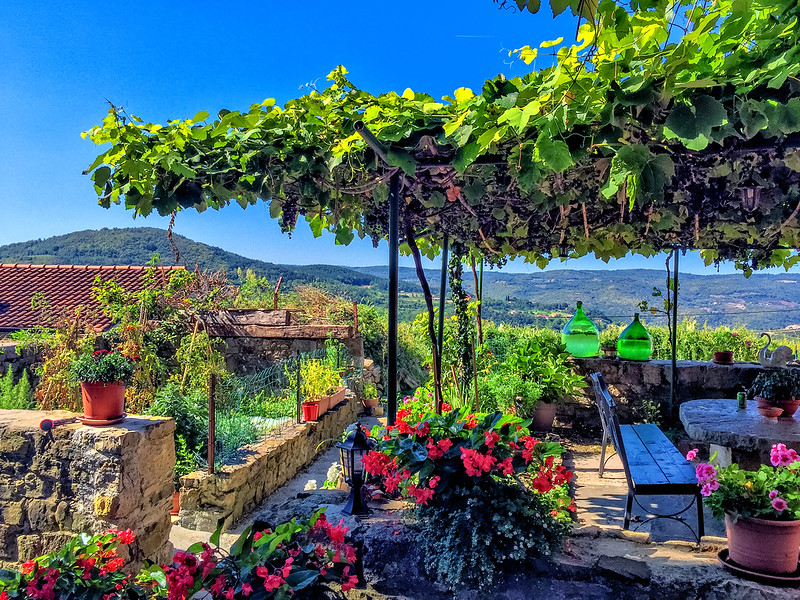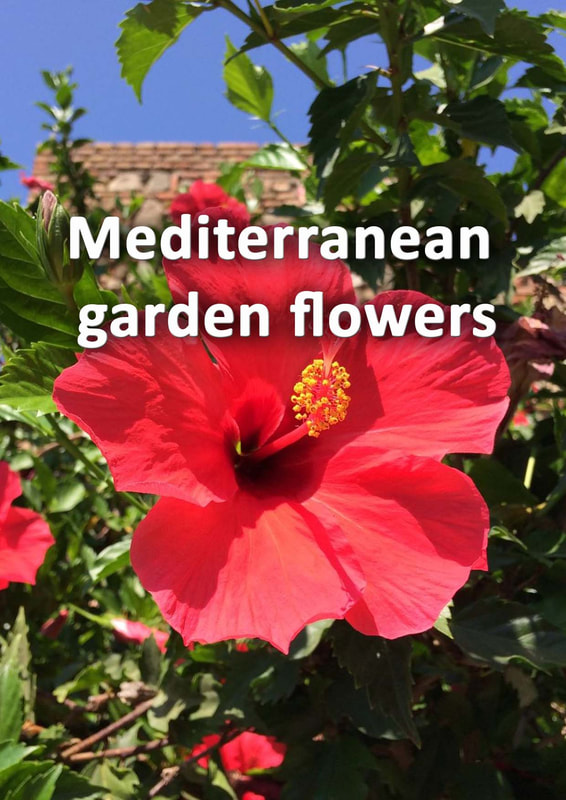|
This article contains affiliate links
The Mediterranean garden style is a combination of landscape features which are typical of the gardens of southern Europe, North Africa and the Middle East. This garden style has evolved from the characteristics of these climates and local, cultural traditions. Mediterranean climates have hot, dry summers with cool or mild winters. This makes them dry and arid in the summer but almost temperate during the winter months. This Mediterranean climate is particularly good for growing fruits such as oranges, peaches and figs. The climate promotes a laid back style of outside living which is also evident in these gardens. Mediterranean gardens have become the ultimate model for low maintenance and high impact landscaping. These gardens celebrate simplicity and appreciate the properties of individual elements without chaos or clutter. Mediterranean gardens are those which provide a warm and sunny sanctuary. A place to talk with friends, a place for family meals or a place to daydream with your favourite drink! Design
For anyone who has had a holiday in Morocco, Italy, Spain, Greece or Turkey, creating a Mediterranean garden at home may seem like a favourable but unachievable dream. However these gardens are much easier to create in cooler climates than some people may think.
Typically plants from the Med can tolerate cold weather and are more affected by excessive wet than cold. Therefore with careful planning and design creating a Mediterranean garden is well within the reach for any region. One beneficial thing to do when designing such a scheme is searching for image examples of Mediterranean gardens you like. These 'precedent images' will provide you with plenty of inspirational ideas for your project. For a more varied scope of styles search individual countries gardens from the Mediterranean regions. For example Moroccan gardens have a style all of their own and use bold colours with a classic Islamic feel! These are some of the most artistic of the Mediterranean gardens. Italy incorporates more formality while Greece has more rusticity and food growing in their gardens.
When you have precedent images of garden elements you like think about how they can be incorporated into your garden. Take pictures of your site from different angles and print them out. Overlay tracing paper and sketch out ideas over individual images.
It is important not to rush this process, keep going back and develop your sketches and ideas. It is surprising how much inspiration can just appear from nowhere when you go through this process. Make sure you resolve the, functional aspects of your design first. Be sure to think about where the sun is during the day and how you will move around the site! With your precedent images and sketches you can now begin to sketch out your new garden design on a plan. Aspect
One of the most important design elements for Mediterranean gardens is aspect. This is particularly so in cooler climates! You will need to maximise all available sunlight to make your garden as warm and vibrant as possible.
You cannot do much about the orientation of your existing garden. Some gardens are west facing and some are east facing, South facing is thought to be the best in the Northern hemisphere. For instance if the sun is always at the back of your garden (north facing) you may wish to consider moving your patio to the rear of the garden. Don’t forget traditionally Mediterranean's build their seating areas in the shade, this is to avoid the strong sun of the day. By painting fences and walls a lighter colour you can also maximise available light. Not only will this make your site lighter it will create a warmer microclimate. Microclimate
Micro climate is a climate which varies from its local or regional climate due to specific conditions of a particular site.
This could be due to excessive shelter or a particular geology which warms up in the sun. Micro climate is the perfect tool in Mediterranean garden design to make your garden warmer. As discussed above by maximising sunlight through reflection you can make your garden both warmer and lighter. You can also aim to block out cold, prevailing wind. For instance in the UK freezing north and easterly winds are always the culprit for tender plant damage early in the season.
Using screening and high evergreen planting you can attempt to block out cold winds.
However the best way to enhance warm microclimates in your garden is with hard surfaces. Materials such as walls, paving and gravels can absorb the suns heat and reflect it. In cities this is known as the ‘heat island effect’ and why towns are always much warmer than the surrounding countryside. If your walls, paving and gravels are light coloured they will reflect the suns light even more. Microclimate will enable to you to design for more sunlight and warmth within your Mediterranean garden. Texture
One of the things Mediterranean gardens do so well is create visual texture. This is generally due to extensive use of hard materials.
From fine gravels to rustic buildings and dry stone walls these gardens celebrate texture. Even on large, extensive surfaces texture is usually added in the form of mosaics or patterning on paved surfaces. Mass plantings of fine leaved plants like lavender and rosemary also add extra texture. The rustic nature of Mediterranean gardens means rough textures can be included with ease. Contrast
A great thing about Mediterranean gardens is they are easy to create juxtaposition and contrast. Alive with visual textures it is easy to evoke emotional responses from bold contrasts. Architectural planting can cast intricate shadows in the afternoon sun.
Light materials can also be contrasted against bold colours as they are in Morocco. Rendered white walls can host the perfect backdrop for a blood red coloured climbing roses. Amongst the dry, arid look of Mediterranean gardens contrast can be added to create drama and dazzle the senses. Outside living
One of the things which define Mediterranean gardens more than anything is the sense of outside living! This can be attributed to the people just as much as the climate and landscape. Being of Greek Cypriot origin myself I have learnt Mediterranean’s seem to enjoy the simple things in life.
The sun coming down of an evening, a light lunch or a coffee with friends! It has to be said that if you are going to create such a garden it should be one that is lived in and not just for show. This function as an outside gathering space is crucial! When I was a boy I remember my cousin Theodosia reaching up and picking a fresh lemon from the tree above. Sitting outside eating together in rural Cyprus was a true example of this idea of outside living. Mediterranean gardens should also be a place of functional abundance with fruit, nuts and herbs fresh for the taking! Create a scene
If there is one thing they do best in the Mediterranean it is enjoying a great view. This is probably much easier on an Italian hillside or Spanish terrace but can be enjoyed in any garden.
Creating an enjoyable scene in your slice of paradise does not have to be a majestic, mountain view. Just an attractive arrangement of terracotta pots up against a wall with your favourite flowers is just as effective. My wife and I created an amazing dry, rockery garden full of succulents. This small garden gets the afternoon and evening sun, perfect for a glass of red wine and an evening meal. We love watching the lowering sun cast shadows across the gravels and rocks. Hours can be spent simply watching this scene and enjoying nature! This is what Mediterranean gardens should be all about! Dry gardens
Dry gardens replicate hot and arid climates with drought resistant plants, rocks and gravels. These gardens typically contain plants such as succulents, palms and grasses. These extremely beautiful gardens can come in a range of forms and variations.
Dry gardens are traditionally combined with raised rockeries in cooler climates. These raised gardens are much better drained than surrounding soils; this makes them perfect for dry loving plants. From raised rockeries to gravel borders and dry river beds, these are perfect accompaniments to a Mediterranean garden theme. Soil
Plants from the Mediterranean do not typically require really rich soils. This is due to the fact they have free draining ground where nutrients are easily washed away. However it is important to note that not all plants have to be from the Mediterranean to work in a Mediterranean garden.
Especially in cooler climates hardy, tropical looking plants such as palms can also be used. Therefore it is good to try to make your soil well drained but fertile. This way you can encourage a wider scope of planting types in your scheme. To prepare your garden soil try to add lots of grit and organic matter. This will help to add oxygen and allow water to drain more easily. Mediterranean plants like good drainage! It is therefore good to build raised beds and also grow in terracotta pots. Mediterranean garden plants
For a climatic region which takes up such a small amount of the world’s surface their plants are extremely tolerant. This is because Mediterranean regions sit geographically half way between the equator and the poles.
This gives them some exposure to both cold and hot conditions meaning they can tolerate a wide scope of conditions. Generally in colder climates Mediterranean plants will rot in wet, boggy soil. Therefore all you have to do is provide well drained, soil conditions.
Generally plants with plenty of good form and architectural foliage fit best in Mediterranean gardens. Fruit and nut trees also work exceptionally well providing tasty edibles. Mediterranean gardens also benefit from colourful flowers and, fragrant blooms. These are perfect for providing evening scent and especially around outside, dining spaces.
21 Mediterranean garden plants
Olive trees
If there had to be one tree at the top of the list then here it is, olives. Olive trees are endemic to Mediterranean regions and will easily grow in cooler climates. Although almost imposable to crop successfully without the Mediterranean sun they process very attractive foliage and form. These drought tolerant trees are perfect for large pots and add height to a patio space. Their grey, blue foliage is extremely effective in both modern and traditional garden styles.
Fig trees
Figs are a tropical looking, small tree but extremely common in the Mediterranean region. With their forked foliage they are extremely aesthetic and can also be trained as a climbing shrub. These are typically grown for their delicious fruit which has a rich syrup like taste. In cooler climates they can be fruited well on a south facing wall. They like root restriction in order to fruit well so good for a large pot.
Citrus
What Mediterranean garden would be complete without some sort of citrus tree? Lemons and Oranges are a typical favourite in these garden styles. These are not as difficult to grow in cooler climates but do need long sunny days in order to fruit well. The best option for these is to grow them in large pots and put them in a greenhouse for the winter months.
Almonds
Almonds and also peaches which are genetically very similar are perfect for Mediterranean gardens. These small trees rarely grow above three metres tall and are extremely attractive. If grown in a suitable microclimate fruit well but their spring blossom alone is sublime.
Quince
These small fruit trees are typical of the Mediterranean and also very ornamental. They have very large, delicate, white flowers which are unusual for a fruit tree. Their yellow, pear like fruits are perfect for jams, jellies and preserves.
Bay tree
Bay trees are well known for their aromatic foliage commonly used in cooking. They do also have very attractive foliage and a restrained growing habit. Bay trees can be trained into lolly pop shapes and even low hedges. These can be a great way to inject some evergreen foliage into a Mediterranean border.
Fan palm
The Hardy Fan Palm or Trachycarpus fortuni is a hardy palm which can make any garden look more exotic. Originally from China this palm can take exceptionally cold conditions and grow to impressive sizes. This makes them perfect for that Mediterranean look even in colder climates. Just give them a sunny well drained position and they will reward you year after year.
Yucca gloriosa
Yucca gloriosa is a very attractive shrub that looks just like an indoor yucca plant. This extremely hardy yucca will live happily outside in temperate climates and even in part shade. Every year it throws up dramatic flower spikes full of dazzling white flowers. Be cautious if you have young children its leaves have very sharp spikes.
Callistemon
Also known as the bottle brush plant this attractive shrub is perfect for Mediterranean gardens. Originally from Australia this shrub has large and attractive red, bottle brush like flowers. In some ways its foliage resembles that of an olive tree. It can be easily pruned into various forms and is very drought tolerant. This shrub also does well in pots and is hardy to -5 degrees Celsius.
Agave
Agaves are extremely impressive plants which very much look like cacti. These are in fact very large succulents and can tolerate quite cold conditions. Traditionally from the Americas some agaves are hardy down to -10; however they do need good drainage! As they look so much like cacti like they are very effective in Mediterranean gardens.
Rosemary
Rosemary is a very well known for its culinary uses but it is also a very attractive evergreen shrub. These useful herbs are great for Mediterranean gardens and can even be clipped into hedges. Releasing a powerful aroma when you brush past, this plant actually smells of the Mediterranean!
Thyme
Another aromatic herb associated with the Mediterranean thyme both looks good and is useful in the kitchen. This plant is great as a ground cover forming large clumps of evergreen foliage. In summer it blooms with carpets of small flowers loved by the bees. This drought tolerant herb is perfect for rockeries or raised planters.
Sage
As well as being used in the kitchen sage also has other beneficial qualities! Sage comes in a range of foliage colours from white to tinted purple. This makes its evergreen foliage very beneficial. Sage also attracts bees, has beautiful flowers and smells wonderful.
Lavender
There are very few who do not appreciate the wonderful aroma of lavender. This small, evergreen shrub is a typical Mediterranean delight. As well as smelling amazing its light, grey foliage is so captivating especially when it dances in the breeze. In summer lavender is covered with striking purple flowers which the bees absolutely love.
Alchemilla mollis
Also known as ladies mantle this low growing, herbaceous perennial is native to southern Europe. It has wonderful, light green foliage which almost looks yellow. This small plant is effectively used as a ground cover in Mediterranean gardens and is extremely hardy.
Arundo donax
If you have ever spent much time in the Mediterranean you are sure to have seen this tall, bamboo like grass. Also known as 'Spanish Cane' this robust reed can reach up to 6 metres in height. This hardy plant naturally survives in lowland areas and marginal areas which completely dry out in the summer. This makes it extremely drought tolerant and hardy.
Pennisetum
These small grasses are very effective in garden borders and are famous for their large, spiky seed heads. Their foliage and seed stems dance in the breeze providing movement and drama. They can be mass planted to create ground cover and have a grey, green foliage.
Euphorbia
Euphorbias are a very large group of plants which have very distinctive, jagged foliage. These interesting plants are generally native to hot climates but are very widespread and hardy. Their foliage displays shades of grey, green through to light yellow. Their general drought tolerance makes them perfect for Mediterranean gardens.
Sedums
Sedums are another wide ranging plant species spanning from large perennials to tiny rock dwelling plants. Sedums are very much like succulents storing water in their leaves. This makes them perfect for dry, arid conditions. Some favourites of this garden theme are sedums like Sedum Herbsfreude ‘Autumn Joy’.
Agapanthus
Agapanthus is actually a very close relation of the onion family. Also known as ‘Lilly of the Nile’ this species is actually native to South Africa and loves warm, sunny conditions. Every summer they throw up magnificent flowering spikes with circular clusters of impressive flower blooms. These look fantastic in Mediterranean planting schemes and even do well in pots.
Artichokes
Artichokes are often more thought of as a vegetable but they are actually extremely attractive, perennial plants. Native to the Mediterranean these very architectural perennials have striking, silver foliage and magnificent blue flowers. That is if you don’t want to harvest them when they are young that is. Their close relative, 'Cardoons' are also very effective in a Mediterranean borders.
Mediterranean garden elements
If you are designing a Mediterranean garden there are some elements which are typical of these gardens. We have listed and described some of these common elements here to help inspire your own Mediterranean garden.
Dry stone walls
Dry stone walls are traditional of Mediterranean regions as rocks are readily available. These aesthetic and rustic features in the landscape are used to contain animals and reinforce boundaries. These can also be very effective in 'Gabions' which are metal cages containing evenly graded rocks. Not only do these look great they can also create micro climates and shelter for wildlife.
Raised beds
Raised beds are particularly good to create well drained planting areas if you have more moisture retentive soil. This is vital in cooler climates as Mediterranean plants can easily rot during the winter months. Raised beds give you the opportunity to choose your own soil type. Typically good quality topsoil with added grit for drainage is perfect. Raised beds can be built with large timbers such as sleepers or masonry. Beds built out of brick and concrete can be painted or surfaced with cladding or tiles.
Pots
Pots are a great way to add extra planting to your garden. They also allow you to raise planting areas up exposing them to more sunlight. Soil inside pots is always better drained than in the ground. Especially if you live in an area with high rainfall pots can provide you with better conditions for drought tolerant plants. They are great for populating warm patios without having to excavate out planting beds.
Gravels
Mediterranean climates don’t really have lawns due to their lack of rainfall. Therefore gravels are a more common surfacing material and can be a good lawn alternative. In cooler climates gravels can be a much cheaper method of surfacing large areas.
The loose gravels can help to lighten up areas and enhance a gardens micro climate. Gravel areas can almost look like miniature deserts and are very effective with plants like palms and succulents. This helps to create that Mediterranean feel and provides extra seating opportunities beyond the patio. Rockeries
Rockeries are a great way to create miniature, mountainous, outcrops in your garden. A good way to save money when excavating a pond or patio is to mound up the soil to create a rockery. The deeper sub-soils in your garden can bake hard in the sun which works really well with rocks.
This effect if done properly can make a very effective garden feature. The well drained crevices between rocks are perfect places to plant succulents and sedums. You can go even further and create sandy hollows in the hope of attracting small reptiles. Patios
Most gardens have some form of patio or seating area. However in Mediterranean gardens they have that little bit more importance. In order to embrace the outside living, lifestyle your garden really needs a generous patio space.
This is so you can host fabulous gatherings with friends and family impressing them with your hospitality. Stone patios in particular help to increase your gardens urban heat island effect making them warmer. Natural stones also help to replicate the natural rusticity of authentic, Mediterranean gardens. Mosaics
Mosaics are an art which date back thousands of years to the Mediterranean region. Ancient Greeks and Romans would put hours of labour into creating these masterpieces.
Some impressive examples of these can be seen in Greek monasteries and Roman settlements like Pompeii. A full sized patio created from Mosaic may be a push for the average garden project. However small mosaics are attainable by using small 'off cuts' of tiles with external adhesive. Outside ovens
Outside ovens are typical of small, Greek gardens and open spaces throughout the Mediterranean. These spherical ovens are capable of reaching exceptional temperatures and can cook multiple dishes at once. My family in Cyprus would heat up their garden oven the night before a social gathering. Foods such as stews and meats would be covered and slow cooked over night.
The next day the food would be cooked perfectly! No rushing about, no work, no panic just full glasses, happy faces and of course happy tummies. There are now similar ovens on the market you can purchase including large pizza ovens. These can also double up as patio heaters, creating heat traps if you utilise good, garden design and planning. Pergolas
Traditional Mediterranean gardens regularly use pergolas of all shapes and sizes. These are not simply aesthetic features but have a more functional aspect. During the summer months the intense heat of the sun would make patios unbearable.
Pergolas with climbing plants like grapes would provide much needed shade as well as fruit. In the autumn the vines would shed their leaves allowing patios to warm in the winter sun. This genius landscape planning can be seen across the Mediterranean and is both functional and aesthetic. Pergolas are a great way to create height and shade in your very own garden project. Lighting
Landscaping with garden lighting is generally more common in the Mediterranean. Particularly in summer night time temperatures are much more favourable. This is probably one of the reasons gatherings go on late into the night! When planning a Mediterranean garden lighting can be an essential ingredient to give your scheme the whole package. As well as providing lighting to seating areas, lights can illuminate focal points, architectural plants and pathways.
Herb gardens
A typical function of traditional Mediterranean gardens is to act as an extension of the kitchen. Herbs for making salads, seasoning food and even herbal teas are a functional delight. Try to adorn your seating areas with the smell of fresh and fragrant herbs. Not only do they look great their scent can be very mood enhancing and appetite enticing! Herbs such as Greek oregano and mint are especially effective and perfect picked fresh from the patio!
Water
Due to water being a scarce resource in hot, Mediterranean climates it is no wonder it is celebrated in gardens. This is more so the case in regions with more Arab influences such as North Africa and Spain. Water is always a good accompaniment to arid style gardens and can represent the fragility of life.
There are many ways of effectively integrating water into your garden space. It can be a simple water feature in the centre of a dry garden or a more elaborate pond. The visual and acoustic effect of water in Mediterranean gardens can be both effective and culturally significant.
For more information and inspiration on Mediterranean gardens I recommend: Create a Mediterranean Garden
I hope you have enjoyed reading my article on how to make a Mediterranean garden. If you want to share your project with us please feel free to send us images. If you need help designing or building a Mediterranean please do not hesitate to contact us.
Thinking of creating your very own Mediterranean garden? Why not visit our Resource page or recommended landscaping tools article here. Our landscape services cover Buckinghamshire, Oxfordshire Hertfordshire and the Chiltern region. Some of our typical project locations include; Amersham, Aylesbury, Beaconsfield, Berkhamsted, Chalfont, Chesham, Gerard's Cross, Great Missenden, High Wycombe, Princes Risborough and Wendover.
2 Comments
7/27/2023 11:14:23 pm
Hello! Your website's content on Mediterranean garden is exceptional. I'm grateful for the effort you put into creating such informative blogs. Your dedication to helping others is inspiring. Keep up the fantastic work!
Reply
Leave a Reply. |
The Author
|
Landscaping services across Buckinghamshire, Amersham, Aylesbury & High Wycombe
Hyde Heath, Amersham, Buckinghamshire |
|










